Discriminating between C3, C4, and Mixed C3/C4 Pasture Grasses of a Grazed Landscape Using Multi-Temporal Sentinel-1a Data
Abstract
1. Introduction
2. Materials and Methods
2.1. Description of Study Site and Selection of Sampling Sites
2.2. Field Measurement (Pasture Composition Data)
2.3. Pre-Processing of Sentinel-1 Data
2.4. Model Data and Pre-Processing
2.5. Model Building and Evaluation
3. Results
3.1. Spatio-Temporal Distribution of C3, C4, and Mixed C3/C4 (MX) Pasture Grass Types
3.2. Optimal Number of Candidate Features
3.3. Selection of Important Model Features
3.4. The Performance of polSAR, glcmTEX, and COMB Models
4. Discussion
4.1. Spatio-Temporal Changes in C3 and C4 Pasture Grasses
4.2. Optimal Hyperparameter and Evaluation of the Random Forest Classification Models
4.3. Evaluation of Livestock Grazing Activities in Discriminating C3, C4, and Mixed C3/C4 Pasture Grasses
4.4. Importance and Uncertainty Analysis of the Study
5. Conclusions
Author Contributions
Funding
Acknowledgments
Conflicts of Interest
References
- Ueno, O. Structural and biochemical characterization of the C3-C4 intermediate Brassica gravinae and relatives, with particular reference to cellular distribution of Rubisco. J. Exp. Bot. 2011, 62, 5347–5355. [Google Scholar] [CrossRef] [PubMed]
- Hattersley, P.W. The distribution of C3 and C4 grasses in Australia in relation to climate. Oecologia 1983, 57, 113–128. [Google Scholar] [CrossRef]
- Lodge, G.; Whalley, R. Seasonal variations in the herbage mass, crude protein and in-vitro digestibility of native perennial grasses on the north-west slopes of New South Wales. Rangel. J. 1983, 5, 20–27. [Google Scholar] [CrossRef]
- Archer, K.A.; Robinson, G.G. Agronomic potential of native grass species on the Northern Tablelands of New South Wales. II. Nutritive value. Aust. J. Agric. Res. 1988, 39, 425–436. [Google Scholar] [CrossRef]
- McPherson, G.R.; Rasmussen, G.A. Seasonal herbivory effects on herbaceous plant communities of the Edwards Plateau. Tex. J. Sci. 1989, 41, 59–70. [Google Scholar]
- Zhang, Q.; Ding, Y.; Ma, W.; Kang, S.; Li, X.; Niu, J.; Hou, X.; Li, X.; Sarula. Grazing primarily drives the relative abundance change of C4 plants in the typical steppe grasslands across households at a regional scale. Rangel. J. 2014, 36, 565–572. [Google Scholar] [CrossRef]
- Davies, K.W.; Boyd, C.S.; Bates, J.D. Eighty Years of Grazing by Cattle Modifies Sagebrush and Bunchgrass Structure. Rangel. Ecol. Manag. 2018, 71, 275–280. [Google Scholar] [CrossRef]
- Mikhailova, E.A.; Bryant, R.; Cherney, D.; Post, C.; Vassenev, I. Botanical composition, soil and forage quality under different management regimes in Russian grasslands. Agric. Ecosyst. Environ. 2000, 80, 213–226. [Google Scholar] [CrossRef]
- Vickery, P.J.; Hill, M.; Donald, G. Satellite derived maps of pasture growth status: Association of classification with botanical composition. Aust. J. Exp. Agric. 1997, 37, 547–562. [Google Scholar] [CrossRef]
- Hill, M.J.; Vickery, P.J.; Furnival, E.P.; Donald, G.E. Pasture land cover in eastern Australia from NOAA-AVHRR NDVI and classified Landsat TM. Remote Sens. Environ. 1999, 67, 32–50. [Google Scholar] [CrossRef]
- Hill, M.J.; Ticehurst, C.J.; Lee, J.-S.; Grunes, M.R.; Donald, G.E.; Henry, D. Integration of optical and radar classifications for mapping pasture type in Western Australia. IEEE Trans. Geosci. Remote Sens. 2005, 43, 1665–1681. [Google Scholar] [CrossRef]
- Wang, C.; Hunt, E.R.; Zhang, L.; Guo, H. Phenology-assisted classification of C3 and C4 grasses in the U.S. Great Plains and their climate dependency with MODIS time series. Remote Sens. Environ. 2013, 138, 90–101. [Google Scholar] [CrossRef]
- Liu, X.; Bo, Y.; Zhang, J.; He, Y. Classification of C3 and C4 Vegetation Types Using MODIS and ETM+ Blended High Spatio-Temporal Resolution Data. Remote Sens. 2015, 7, 15244–15268. [Google Scholar] [CrossRef]
- Peterson, D.L.; Price, K.P.; Martinko, E.A. Discriminating between cool season and warm season grassland cover types in northeastern Kansas. Int. J. Remote Sens. 2002, 23, 5015–5030. [Google Scholar] [CrossRef]
- Shoko, C.; Mutanga, O. Seasonal discrimination of C3 and C4 grasses functional types: An evaluation of the prospects of varying spectral configurations of new generation sensors. Int. J. Appl. Earth Obs. Geoinf. 2017, 62, 47–55. [Google Scholar] [CrossRef]
- Shoko, C.; Mutanga, O. Examining the strength of the newly-launched Sentinel 2 MSI sensor in detecting and discriminating subtle differences between C3 and C4 grass species. ISPRS J. Photogramm. Remote Sens. 2017, 129, 32–40. [Google Scholar] [CrossRef]
- Lamb, D.W.; Steyn-Ross, M.; Schaare, P.; Hanna, M.M.; Silvester, W.; Steyn-Ross, A. Estimating leaf nitrogen concentration in ryegrass (Lolium spp.) pasture using the chlorophyll red-edge: Theoretical modelling and experimental observations. Int. J. Remote Sens. 2002, 23, 3619–3648. [Google Scholar] [CrossRef]
- Prabhakara, K.; Hively, W.D.; McCarty, G.W. Evaluating the relationship between biomass, percent groundcover and remote sensing indices across six winter cover crop fields in Maryland, United States. Int. J. Appl. Earth Obs. Geoinf. 2015, 39, 88–102. [Google Scholar] [CrossRef]
- Asrar, G.; Fuchs, M.; Kanemasu, E.; Hatfield, J. Estimating Absorbed Photosynthetic Radiation and Leaf Area Index from Spectral Reflectance in Wheat 1. Agron. J. 1984, 76, 300–306. [Google Scholar] [CrossRef]
- Gallo, K.P.; Daughtry, C.S.T. Techniques for Measuring Intercepted and Absorbed Photosynthetically Active Radiation in Corn Canopies 1. Agron. J. 1986, 78, 752–756. [Google Scholar] [CrossRef]
- Schmullius, C.C.; Evans, D.L. Review article Synthetic aperture radar (SAR) frequency and polarization requirements for applications in ecology, geology, hydrology, and oceanography: A tabular status quo after SIR-C/X-SAR. Int. J. Remote Sens. 1997, 18, 2713–2722. [Google Scholar] [CrossRef]
- McNairn, H.; Brisco, B. The application of C-band polarimetric SAR for agriculture: A review. Can. J. Remote Sens. 2004, 30, 525–542. [Google Scholar] [CrossRef]
- Cloude, S.R.; Pottier, E. A review of target decomposition theorems in radar polarimetry. IEEE Trans. Geosci. Remote Sens. 1996, 34, 498–518. [Google Scholar] [CrossRef]
- Freeman, A.; Durden, S.L. Three-component scattering model to describe polarimetric SAR data. IEEE Trans. Geosci. Remote Sens. 1998, 36, 963–973. [Google Scholar] [CrossRef]
- Yamaguchi, Y.; Moriyama, T.; Ishido, M.; Yamada, H. Four-component scattering model for polarimetric SAR image decomposition. IEEE Trans. Geosci. Remote Sens. 2005, 43, 1699–1706. [Google Scholar] [CrossRef]
- Waske, B.; Braun, M. Classifier ensembles for land cover mapping using multitemporal SAR imagery. ISPRS J. Photogramm. Remote Sens. 2009, 64, 450–457. [Google Scholar] [CrossRef]
- Buckley, J.R.; Smith, A.M. Monitoring grasslands with radarsat 2 quad-pol imagery. In Proceedings of the 2010 IEEE International Geoscience and Remote Sensing Symposium, Honolulu, HI, USA, 25–30 July 2010; pp. 3090–3093. [Google Scholar]
- Haldar, D.; Chakraborty, M.; Manjunath, K.R.; Parihar, J.S. Role of Polarimetric SAR data for discrimination/biophysical parameters of crops based on canopy architecture. ISPRS Int. Arch. Photogramm. Remote Sens. Spat. Inf. Sci. 2014, XL–8, 737–744. [Google Scholar] [CrossRef]
- Smith, A.M.; Buckley, J.R. Investigating RADARSAT-2 as a tool for monitoring grassland in western Canada. Can. J. Remote Sens. 2011, 37, 93–102. [Google Scholar] [CrossRef]
- Skriver, H. Crop classification by multitemporal C- and L-band single- and dual-polarization and fully polarimetric SAR. IEEE Trans. Geosci. Remote Sens. 2012, 50, 2138–2149. [Google Scholar] [CrossRef]
- Larrañaga, A.; Álvarez-Mozos, J. On the added value of quad-pol data in a multi-temporal crop classification framework based on RADARSAT-2 imagery. Remote Sens. 2016, 8, 335. [Google Scholar] [CrossRef]
- Mascolo, L.; Lopez-Sanchez, J.M.; Vicente-Guijalba, F.; Nunziata, F.; Migliaccio, M.; Mazzarella, G. A complete procedure for crop phenology estimation with PolSAR data based on the complex Wishart classifier. IEEE Trans. Geosci. Remote Sens. 2016, 54, 6505–6515. [Google Scholar] [CrossRef]
- Bargiel, D. A new method for crop classification combining time series of radar images and crop phenology information. Remote Sens. Environ. 2017, 198, 369–383. [Google Scholar] [CrossRef]
- Berberoğlu, S.; Akin, A.; Atkinson, P.M.; Curran, P.J. Utilizing image texture to detect land-cover change in Mediterranean coastal wetlands. Int. J. Remote Sens. 2010, 31, 2793–2815. [Google Scholar] [CrossRef]
- Haralick, R.M.; Shanmugam, K.; Its’Hak, D. Textural Features for Image Classification. IEEE Tran. Syst. Man Cybern. 1973, SMC-3, 610–621. [Google Scholar] [CrossRef]
- Hall-Beyer, M. GLCM Texture: A Tutorial v. 3.0 March 2017; University of Calgary: Calgary, AB, Canada, 2017. [Google Scholar]
- Rodriguez-Galiano, V.F.; Chica-Olmo, M.; Abarca-Hernandez, F.; Atkinson, P.M.; Jeganathan, C. Random Forest classification of Mediterranean land cover using multi-seasonal imagery and multi-seasonal texture. Remote Sens. Environ. 2012, 121, 93–107. [Google Scholar] [CrossRef]
- Beekhuizen, J.; Clarke, K.C. Toward accountable land use mapping: Using geocomputation to improve classification accuracy and reveal uncertainty. Int. J. Appl. Earth Obs. Geoinf. 2010, 12, 127–137. [Google Scholar] [CrossRef]
- Wang, M.; Fei, X.; Zhang, Y.; Chen, Z.; Wang, X.; Tsou, J.Y.; Liu, D.; Lu, X. Assessing texture features to classify coastal wetland vegetation from high spatial resolution imagery using completed local binary patterns (CLBP). Remote Sens. 2018, 10, 778. [Google Scholar] [CrossRef]
- Wikantika, K.; Uchida, S.; Yamamoto, Y. An evaluation of the use of integrated spectral and textural features to identify agricultural land cover types in Pangalengan, West Java, Indonesia. Jpn. Agric. Res. Q. 2004, 38, 137–148. [Google Scholar] [CrossRef]
- Zhang, X.; Feng, X.; Jiang, H. Object-oriented method for urban vegetation mapping using IKONOS imagery. Int. J. Remote Sens. 2010, 31, 177–196. [Google Scholar] [CrossRef]
- Hill, M.J.; Smith, A.M.; Foster, T.C. Remote Sensing of Grassland with RADARSAT; Case studies from Australia and Canada. Can. J. Remote Sens. 2000, 26, 285–296. [Google Scholar] [CrossRef]
- Treitz, P.M.; Howarth, P.J.; Filho, O.R.; Soulis, E.D. Agricultural crop classification using SAR tone and texture statistics. Can. J. Remote Sens. 2000, 26, 18–29. [Google Scholar] [CrossRef]
- Zhou, T.; Pan, J.; Zhang, P.; Wei, S.; Han, T. Mapping winter wheat with multi-temporal SAR and optical images in an urban agricultural region. Sensors 2017, 17, 1210. [Google Scholar] [CrossRef] [PubMed]
- Breiman, L. Random Forests. Mach. Learn. 2001, 45, 5–32. [Google Scholar] [CrossRef]
- Gislason, P.O.; Benediktsson, J.A.; Sveinsson, J.R. Random Forests for land cover classification. Pattern Recognit. Lett. 2006, 27, 294–300. [Google Scholar] [CrossRef]
- Díaz-Uriarte, R.; Alvarez de Andrés, S. Gene selection and classification of microarray data using random forest. BMC Bioinform. 2006, 7, 3. [Google Scholar] [CrossRef] [PubMed]
- Shi, D.; Yang, X. An Assessment of Algorithmic Parameters Affecting Image Classification Accuracy by Random Forests. Available online: https://www.ingentaconnect.com/content/asprs/pers/2016/00000082/00000006/art00010%3bjsessionid=3e039vgfeg5ce.x-ic-live-03# (accessed on 20 November 2018).
- Adelabu, S.; Dube, T. Employing ground and satellite-based QuickBird data and random forest to discriminate five tree species in a Southern African Woodland. Geocarto Int. 2015, 30, 457–471. [Google Scholar] [CrossRef]
- Yan, D.; de Beurs, K.M. Mapping the distributions of C3 and C4 grasses in the mixed-grass prairies of southwest Oklahoma using the Random Forest classification algorithm. Int. J. Appl. Earth Obs. Geoinf. 2016, 47, 125–138. [Google Scholar] [CrossRef]
- Adjorlolo, C.; Mutanga, O.; Ismail, R.; Cho, M.A. Optimizing spectral resolutions for the classification of C3 and C4 grass species, using wavelengths of known absorption features. J. Appl. Remote Sens. 2012, 6, 063560. [Google Scholar] [CrossRef]
- Isbell, R.F. The Australian Soil Classification; Australian soil and land survey handbook; CSIRO Australia: Collingwood, VIC, Australia, 1996; ISBN 978-0-643-05813-2. [Google Scholar]
- BoM Climate Statistics for Australian Locations. Available online: http://www.bom.gov.au/climate/averages/tables/cw_056037_All.shtml (accessed on 21 October 2018).
- Tothill, J.C.; Jones, R.M.; Hargreaves, J.N.G.; Commonwealth Scientific and Industrial Research Organization (Australia); Division of Tropical Crops and Pastures. BOTANAL: A Comprehensive Sampling and Computing Procedure for Estimating Pasture Yield and Composition; CSIRO, Division of Tropical Crops and Pastures: Brisbane, Australia, 1978; ISBN 978-0-643-02797-8. [Google Scholar]
- Liu, C.; Berry, P.M.; Dawson, T.P.; Pearson, R.G. Selecting thresholds of occurrence in the prediction of species distributions. Ecography 2005, 28, 385–393. [Google Scholar] [CrossRef]
- Open Access Hub. Available online: https://scihub.copernicus.eu/ (accessed on 22 October 2018).
- Lee, J.-S. Refined filtering of image noise using local statistics. Comput. Graph. Image Process. 1981, 15, 380–389. [Google Scholar] [CrossRef]
- Crabbe, R.A.; Lamb, D.W. Estimating Biophysical Variables of Pasture Cover Using Sentinel-1 Data; Precision Agriculture NZ Inc.: Christchurch, New Zealand, 2017. [Google Scholar]
- Verma, N.; Lamb, D.; Reid, N.; Wilson, B. Comparison of Canopy Volume Measurements of Scattered Eucalypt Farm Trees Derived from High Spatial Resolution Imagery and LiDAR. Remote Sens. 2016, 8, 388. [Google Scholar] [CrossRef]
- Le Toan, T.; Beaudoin, A.; Riom, J.; Guyon, D. Relating forest biomass to SAR data. IEEE Trans. Geosci. Remote Sens. 1992, 30, 403–411. [Google Scholar] [CrossRef]
- Ranson, K.J.; Sun, G. Northern forest classification using temporal multifrequency and multipolarimetric SAR images. Remote Sens. Environ. 1994, 47, 142–153. [Google Scholar] [CrossRef]
- Toolboxes. Available online: https://sentinel.esa.int/web/sentinel/toolboxes (accessed on 22 October 2018).
- Lyons, M.B.; Keith, D.A.; Phinn, S.R.; Mason, T.J.; Elith, J. A comparison of resampling methods for remote sensing classification and accuracy assessment. Remote Sens. Environ. 2018, 208, 145–153. [Google Scholar] [CrossRef]
- Bogner, C.; Seo, B.; Rohner, D.; Reineking, B. Classification of rare land cover types: Distinguishing annual and perennial crops in an agricultural catchment in South Korea. PLoS ONE 2018, 13, e0190476. [Google Scholar] [CrossRef] [PubMed]
- Maxwell, A.E.; Warner, T.A.; Fang, F. Implementation of machine-learning classification in remote sensing: An applied review. Int. J. Remote Sens. 2018, 39, 2784–2817. [Google Scholar] [CrossRef]
- Kuhn, M. Building Predictive Models in R Using the caret Package. J. Stat. Softw. 2008, 28. [Google Scholar] [CrossRef]
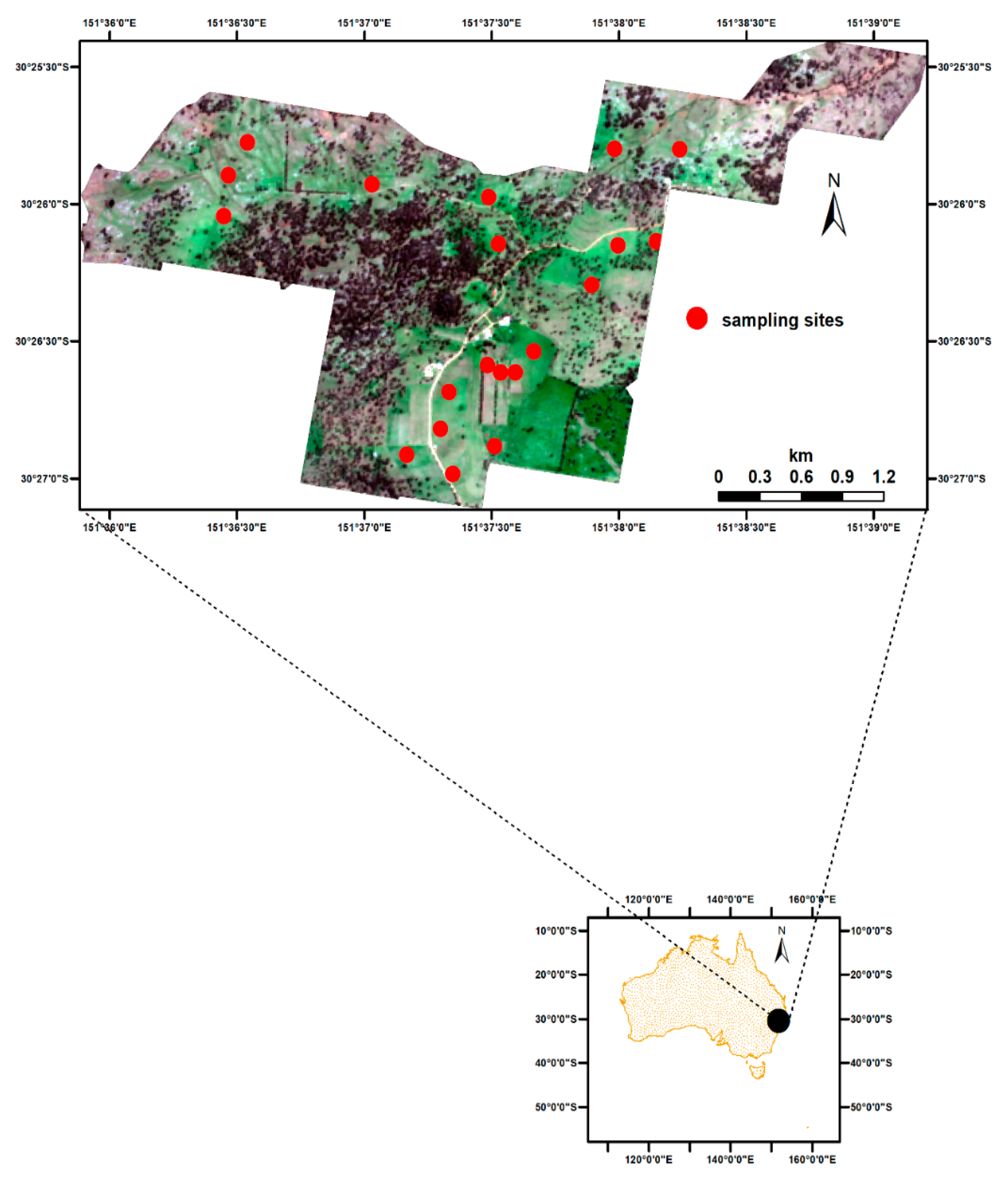
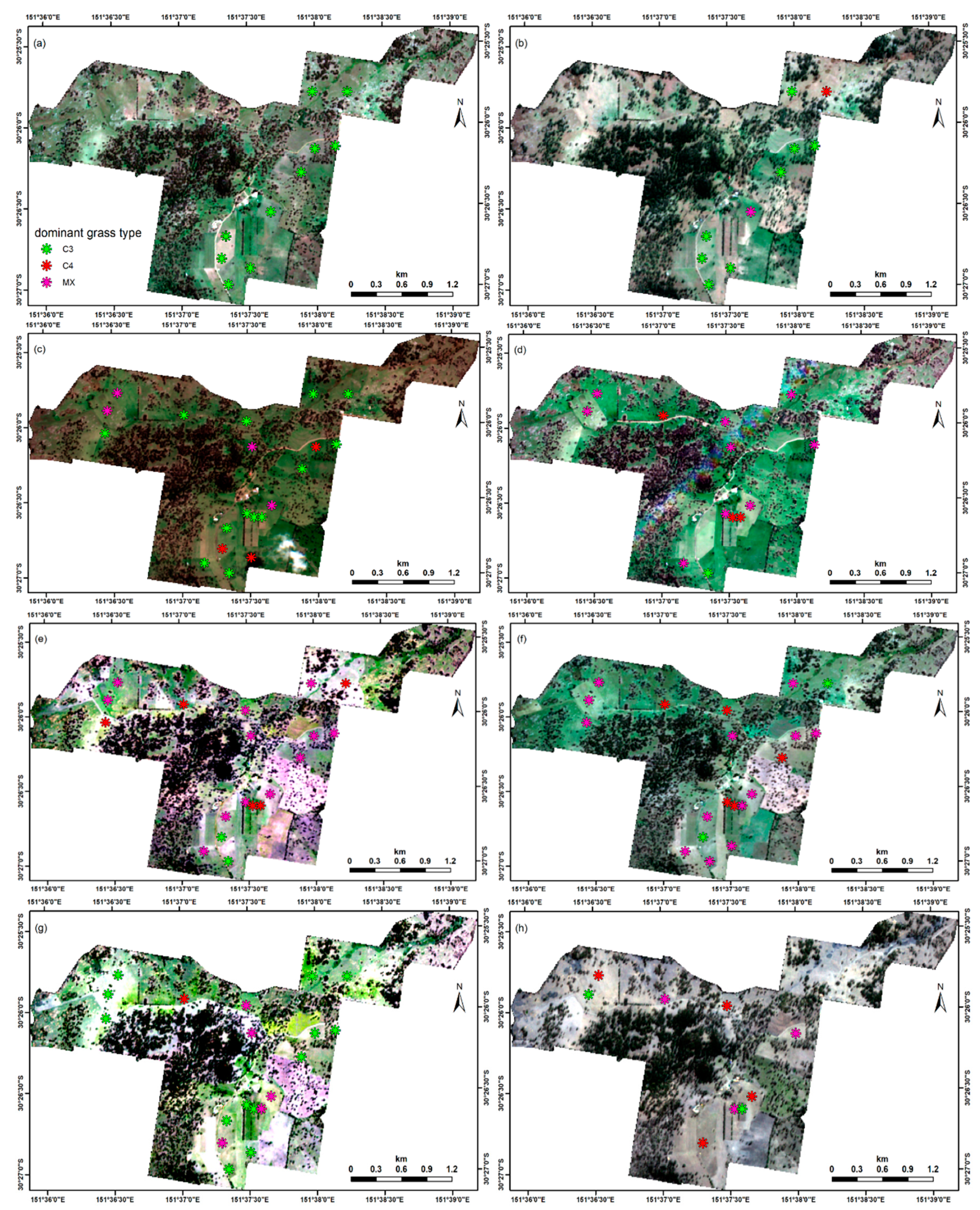
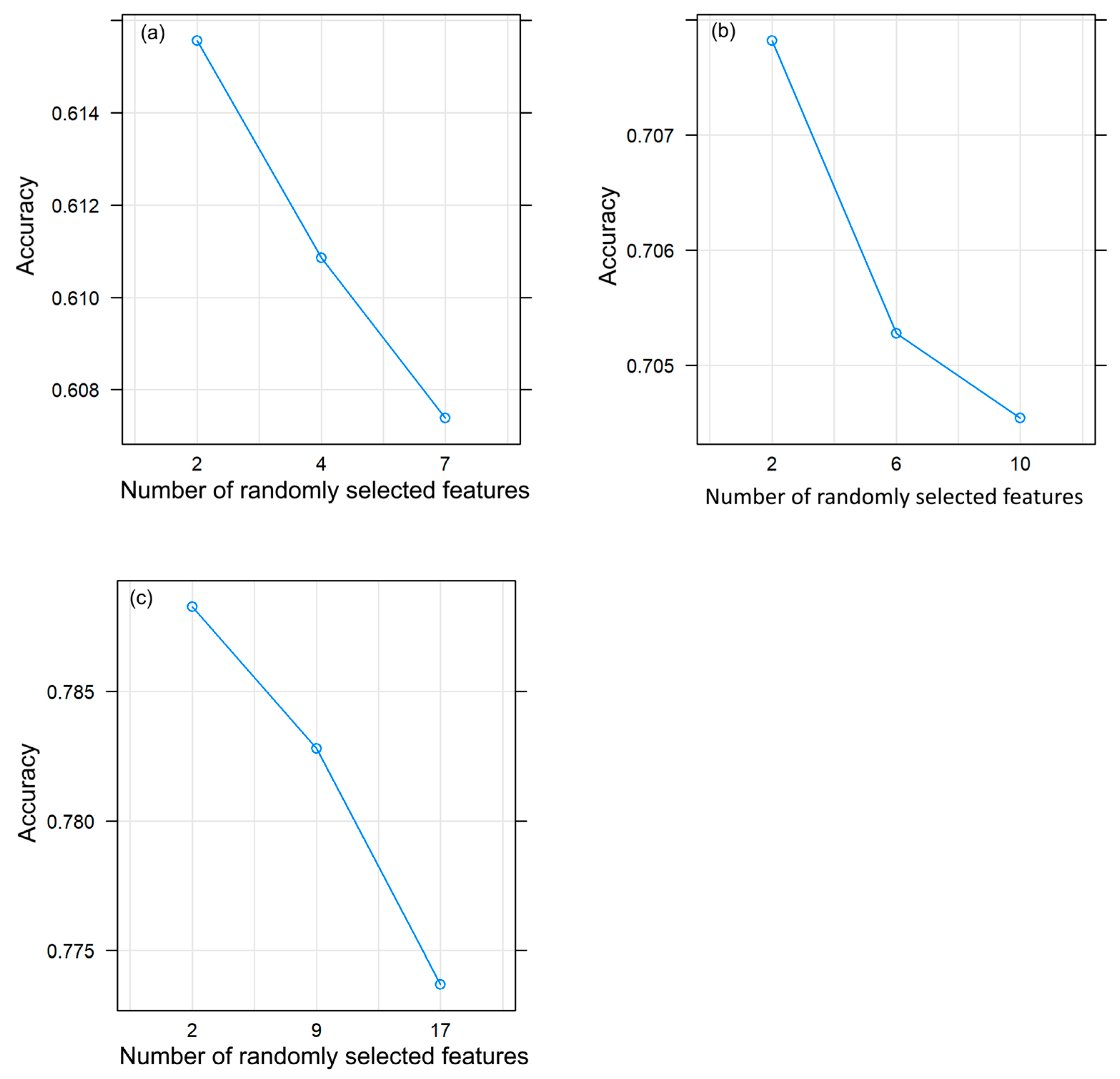
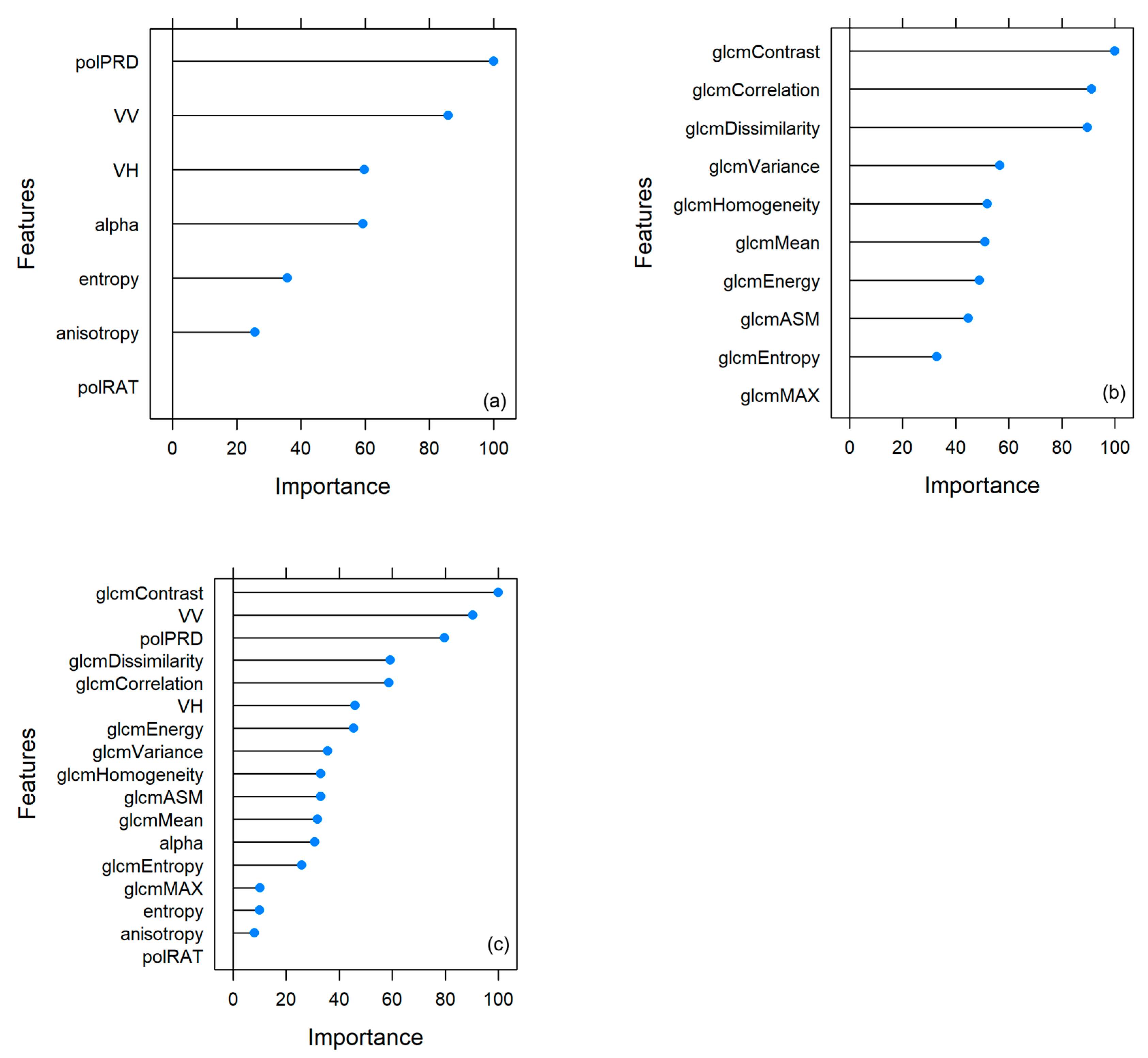
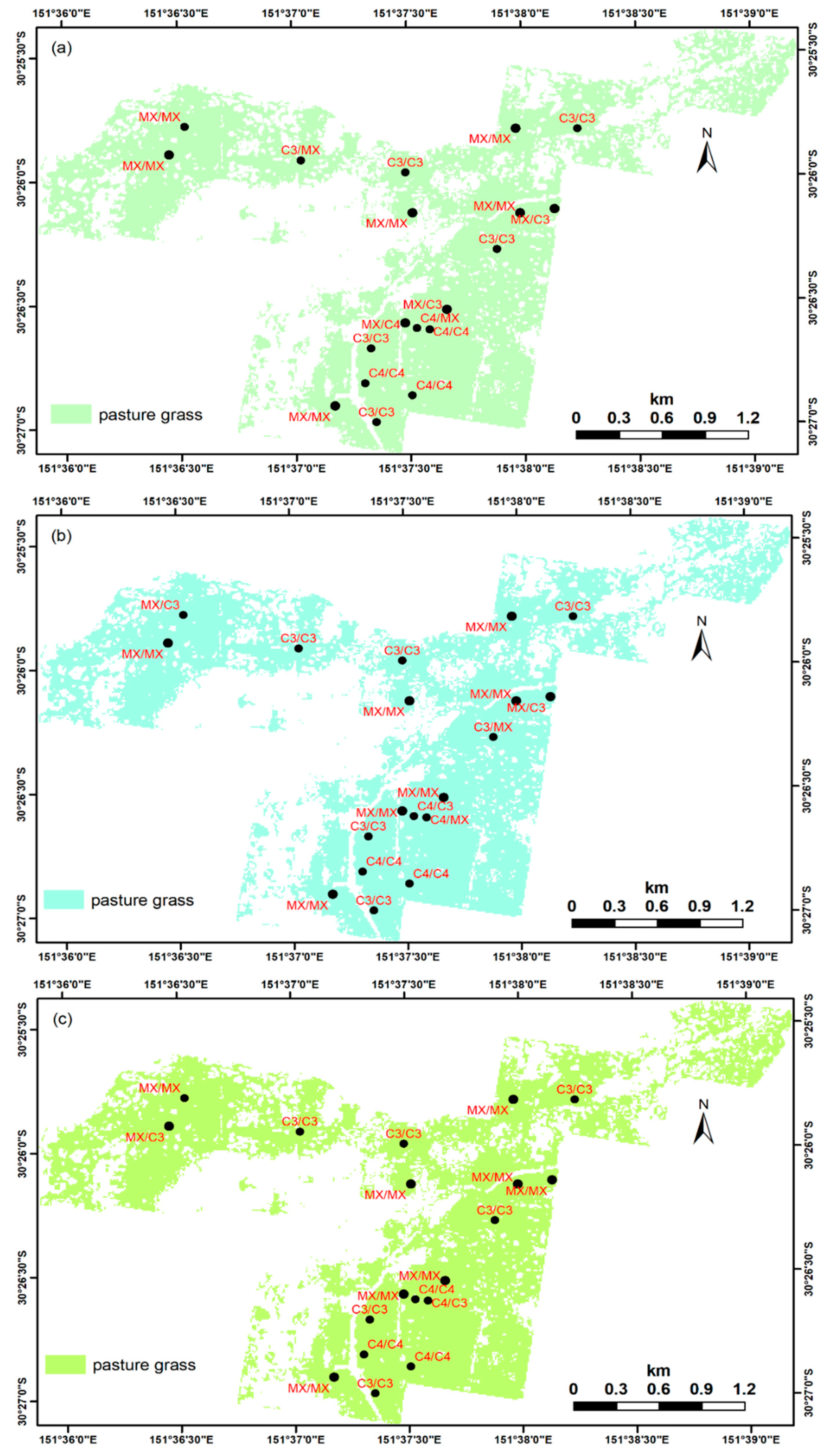

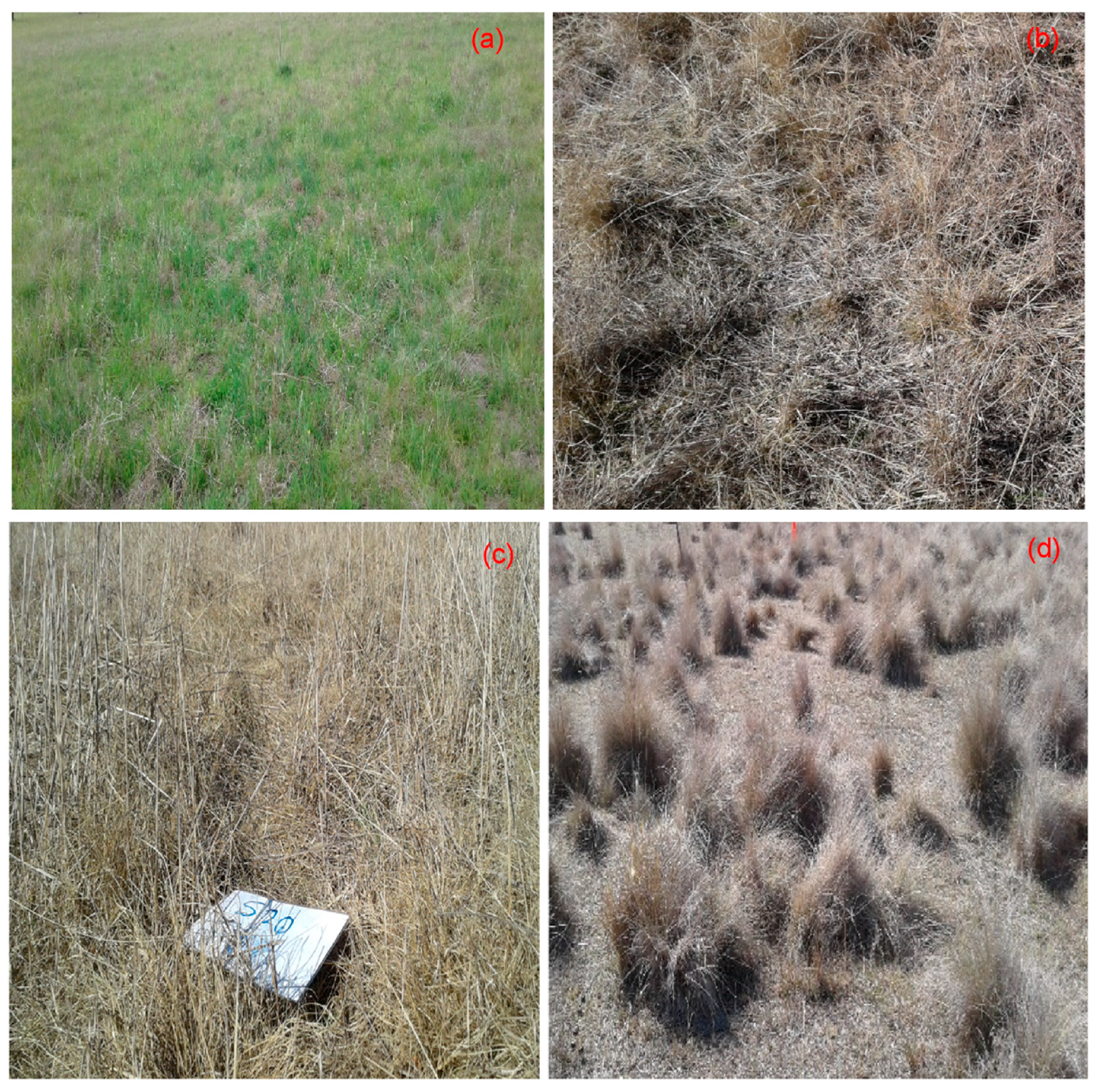
| Field Measurement Date | Sentinel-1 Overpass Date |
|---|---|
| 13 February, 2017 | 13 February, 2017 |
| 6 July, 2017 | 7 July, 2017 |
| 11 October, 2017 | 11 October, 2017 |
| 12 December, 2017 | 10 December, 2017 |
| 16 January, 2018 | 15 January, 2018 |
| 8 February, 2018 | 8 February, 2018 |
| 16 March, 2018 | 16 March, 2018 |
| 26 July, 2018 | 26 July, 2018 |
| C3 Species | C4 Species |
|---|---|
| Poa tussock (Poa labillardierei) | Parramatta grass (Sporobolus elongatus) |
| Wheat grass (Anthosachne scabra) | Red grass (Bothriochloa macra) |
| Phalaris (Phalaris aquatica) | Paspalum (Paspalum dilatatum) |
| Wallaby grass (Austrodanthonia spp.) | Paddock lovegrass (Eragrostis leptostachya) |
| Cocksfoot (Dactylis glomerata) | Panic grass (Panicum effusum) |
© 2019 by the authors. Licensee MDPI, Basel, Switzerland. This article is an open access article distributed under the terms and conditions of the Creative Commons Attribution (CC BY) license (http://creativecommons.org/licenses/by/4.0/).
Share and Cite
Crabbe, R.A.; Lamb, D.W.; Edwards, C. Discriminating between C3, C4, and Mixed C3/C4 Pasture Grasses of a Grazed Landscape Using Multi-Temporal Sentinel-1a Data. Remote Sens. 2019, 11, 253. https://doi.org/10.3390/rs11030253
Crabbe RA, Lamb DW, Edwards C. Discriminating between C3, C4, and Mixed C3/C4 Pasture Grasses of a Grazed Landscape Using Multi-Temporal Sentinel-1a Data. Remote Sensing. 2019; 11(3):253. https://doi.org/10.3390/rs11030253
Chicago/Turabian StyleCrabbe, Richard Azu, David William Lamb, and Clare Edwards. 2019. "Discriminating between C3, C4, and Mixed C3/C4 Pasture Grasses of a Grazed Landscape Using Multi-Temporal Sentinel-1a Data" Remote Sensing 11, no. 3: 253. https://doi.org/10.3390/rs11030253
APA StyleCrabbe, R. A., Lamb, D. W., & Edwards, C. (2019). Discriminating between C3, C4, and Mixed C3/C4 Pasture Grasses of a Grazed Landscape Using Multi-Temporal Sentinel-1a Data. Remote Sensing, 11(3), 253. https://doi.org/10.3390/rs11030253






